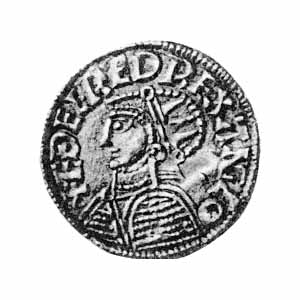In my current classic D&D campaigns, I’ve switched to a “silver standard”, and I describe the coins this way:
By Arichis at en.wikipedia [Public domain], from Wikimedia Commons
- Gold is treasure
- Silver is money
- Copper is change
Which is really the whole point of the change. Having the PCs start the game with 100 gold coins to spend (even if it really only represents their net worth rather than actual coinage), dampens the impact of finding a coffer of gold coins.
But I find that the 1gp:10sp:100cp ratios (call it “tens, dollars, and dimes”) that I’m using—because it made converting from standard values to mine easier—don’t quite give that feel. I’m thinking 1gp:100sp:10,000cp (hundreds, dollars, and pennies) would better represent those distinctions.
One of the sources I like to borrow from is history. (Plus, it gives me an excuse to learn about history.) So, I took a look at the coins during the reign of Edward III and Roman currency. Neither of which really have anything close to a 1:100:10,000 trio to use as a model. Which is disappointing.
Maybe 1:20:400 would be sufficient? Although, failing the history reality-check doesn’t count 1:10:10,000 out completely.
Either way, it makes the math between classic D&D and my D&D values more difficult.

9 comments:
A Roman gold piece struck in Caesar's time was worth 25 denarii or silver pieces, but the same coin would be worth about 75-85 denier, the most common medieval silver coin, by weight. The English gold noble was worth 80 pence or denier.
Most kingdoms only struck silver coins. They didn't really use copper coins in the middle ages, except the Byzantines, who didn't really use silver - they had copper coins at something like 6,000 per gold piece, usually issued in denominations of 40, although single coins existed as well. The Byzantine gold piece was a fairly common internationally used gold coin, and was about half the weight of the (non-contemporaneous) English noble.
That means if you dug up an ancient Roman gold piece somewhere in medieval Europe, you could exchange it for 80 modern silver pieces, and then go a bit further east and change your silver for 150 copper pieces each.
Mind you, those copper pieces would be nigh worthless. 20 coppers for a pint of ale, 80 coppers for a dozen eggs, that sort of thing.
A 10:1 rate of exchange of silver to gold by weight is pretty close to historical, but copper is anybody's guess. As John notes, the Byzantines used copper, but the crusaders were really angry when forced to exchange their precious metals for coins worth nominal value in order to buy things when passing through. It is worth noting, though, that debased medieval coinage tends to be mostly copper and a bit of silver, which can get you very close to 1:10:10,000 (just make sure your "copper coins have something of the order of 1/100 silver content). Here is a link to a short article and PDF survey of historical coinage I wrote up for gaming purposes:
http://silverbladeadventures.blogspot.jp/2010/07/article-yggsburgh-coinage.html
@Matt: I understand the "traditional" exchange by weight was 1:20:240 for gold:silver:copper. Hence the livre/sou/denier and its various descendents, in emulation of the Roman gold/silver/copper pieces, even though the coins themselves were all struck of silver. Obviously the actual exchange rate varied.
No, that is not an exchange rate, that is literally the number of silver coins to make a pound of silver (hence livre, or in English a pound). There are 12 silver coins (deniers) in a "sou" or shilling and twenty shillings to the pound. Of course, that is a Trojan (5,760 grains) or Tower Pound (5,400 grains). A penny weight is 24 grains (24 times 240 = 5,760), though in reality pennies were struck at 22.5 grains (22.5 times 240 = 5,400) at the Tower of London. A modern pound is 7,000 grains for comparison, but precious metals are still weighed using the "trojan" standard, meaning that a pound of gold is actually lighter than a pound of feathers. :D
Thanks for the discussion, guys!
@Matt: I know. What I mean is that those subdivisions were chosen based on the the idea that gold was 20 times more valuable than silver, and silver 12 times more valuable than copper. The denier was actually silver, and the sou and livre were units of account not coins, but when Charlemange established his silver standard he used those values in emulation of the Roman gold/silver/copper standard. That might be false information, I can't remember where I read it.
As far as I am aware there is nothing to the idea that Charlemagne based his 1/12/20 division on Byzantine or Roman copper/silver/gold exchange rates, and I am not aware of any parallel coinage that would fit the bill. There is a relationship in the names, though:
Etymologically, the "denier" is derived from the Roman denarius (or silver coin) and the "sou" is derived from the Roman solidus (or gold coin), but the contemporary latter coin is too heavy to be equivalent to 12 silver denier (288 grains of silver to 72 grains of gold).
Another contender, however, is the tremissis, which was current at the time, issued by the Byzantines imitated by western "Barbarian" kings and one third the weight of the solidus, meaning that 12 denier (24 grains) would be worth 1 tremissis (24 grains). That is a little high and possibly explains why the weight ended up 21.5 grains.
Anyway, it is possible that the 1/12/20 system relates to an exchange rate of some sort, but at this time I do not think so.
Post a Comment